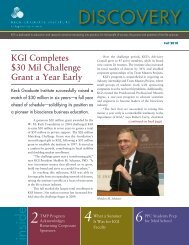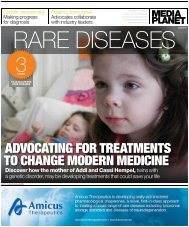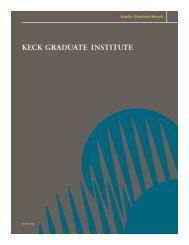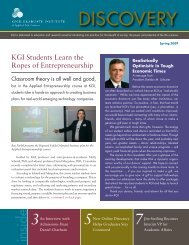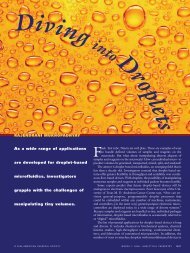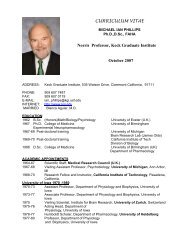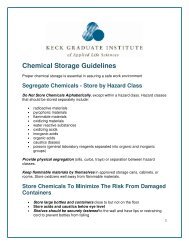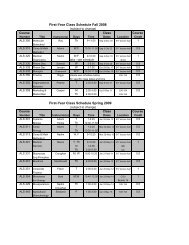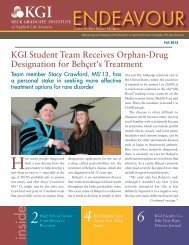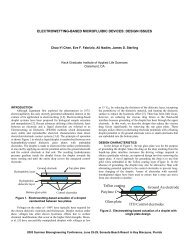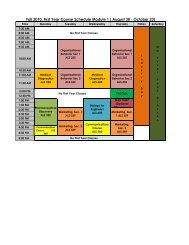team masters project presenta tions - Keck Graduate Institute
team masters project presenta tions - Keck Graduate Institute
team masters project presenta tions - Keck Graduate Institute
- No tags were found...
You also want an ePaper? Increase the reach of your titles
YUMPU automatically turns print PDFs into web optimized ePapers that Google loves.
Team Masters Project Presenta<strong>tions</strong>The Team Masters Project (TMP) is the capstone activity for second-yearstudents in the Master of Bioscience program at <strong>Keck</strong><strong>Graduate</strong> <strong>Institute</strong> of Applied Life Sciences (KGI).Interdisciplinary <strong>team</strong>s of three to five students workwith sponsoring companies to solve real problems.This <strong>project</strong> replaces the Masters thesis work requiredin traditional programs. Several of the <strong>project</strong>s this yearwere provided additional manpower during the 2ndsemester in the form of first-year students who enrolledin the TMP as an elective.The <strong>team</strong>s are advised by KGI faculty and an industry liaison. TMPactivities emphasize problem-solving, <strong>project</strong> management,productive <strong>team</strong>work, and effective communica<strong>tions</strong>:skills that will be critically important to KGI graduatesas they pursue careers in the bioscience industries.Representing about 35 percent of the academic workfor second-year students, these contract research <strong>project</strong>sare designed to produce specific sets of deliverables forthe sponsoring companies.The TMP program also benefits from involvement of students and facultyfrom other colleges. This year, the Gilead <strong>project</strong>on inspection systems was a joint KGI—HarveyMudd College engineering clinic <strong>project</strong>. We also hadparticipation of Harvey Mudd College Biology andJoint Sciences Department students.
Project SummariesEvaluation of Alternative Methods for Leptin ProductionSponsor CompanyCorporate Liaison:Dr. Mary EricksonFaculty Advisor:Prof. Jim CreggConsulting Scientists:Dr. Anasua KusariDr. Ilya TolstorukovStudents: Jennifer Boyd, Tyler Bradley-Hewitt (CMC),Zeynab Moradi, Ranjani Sundharam, Brian WatkinsOver the past decade, several advances have been made inrecombinant DNA technology and heterologous proteinexpression. Such advances have had a direct impact on theefficiency with which pharmaceutical and biotechnologycompanies can produce therapeutic protein products, thusfueling growth for a market which now accounts for 10% ofall pharmaceutical sales. Leptin is a naturally occurring proteinhormone secreted by adipose tissue and acts as a signal to thehypothalamus to regulate food intake and energy expenditure.Studies have shown that leptin given in combination withamylin, a second hormone linked to fat metabolism, results insustained, fat-specific weight loss in a leptin-resistant animalmodel of obesity. Thus, leptin, in combination with pramlintide,an amylin analog, is currently being investigated by AmylinPharmaceuticals as a treatment for obesity. The primaryobjective of the <strong>project</strong> undertaken by the KGI <strong>team</strong> was toevaluate the yeast Pichia pastoris as a possible manufacturingcell line and analyze the commercial feasibility of using aP. pastoris expression system for the production of human leptin.Since the company is investigating leptin for use in a combinationtherapy, a crucial factor is to minimize the drug substance costof goods manufactured (COGM). One way to keep COGM lowis to find an efficient expression host that may also minimizedownstream processing. The <strong>project</strong> helped Amylin determinewhether P. pastoris can be a commercially acceptable alternativeto the current system for producing the leptin protein. Thetechnical assessment provided results for product titer, yield,and quality, as well as data that can be used to perform amatrix analysis to estimate cost of goods manufactured.The report also included an intellectual property analysis,a contract manufacturing assessment, evaluation of regulatoryissues, and bioprocess models produced using SuperPro .Combined, this information allows Amylin to begin assessingP. pastoris as an alternative expression system for themanufacture of human leptin.
Evaluation of Delivery Systems for Chronic Therapy inDiabetes and ObesitySponsor CompanyCorporate Liaison:Dr. David LitzingerFaculty Advisor:Prof. Karen MoynihanStudents: Naomi Arana, Shi Yu Chang, Tianhao Han,Sarah Moore (HMC), Kimberly SevillaAmylin Pharmaceuticals Inc. is committed to the discovery,development and commercialization of novel medicines forthe treatment of metabolic diseases. With two first-in-classproducts on the market, SYMLIN ® (pramlintide acetate) andBYETTA ® (exenatide), Amylin is continually striving to meetthe therapeutic needs of patients. The goal of the <strong>project</strong> wasto apply novel drug delivery technologies to Amylin’s activepharmaceutical ingredients, yielding a new generation ofproducts that reduce the frequency of patient-driven dosingwhile enhancing patient compliance.Using a comprehensive, multidisciplinary approach, severalimplantable drug delivery systems were evaluated for potentialinclusion as treatment op<strong>tions</strong> within the diabetes and obesitytherapeutics market. Historically, implantable drug deliverydevices have been developed for a variety of therapeutic areasincluding pain management, viral infection, delivery of hormonesand cancer treatment. The drug delivery systems investigatedfor Amylin were generally small devices designed to besubcutaneously implanted in patients. The devices providecontrolled and sustained delivery of drug for extended periodsof time. To assess the market for implantable devices, the <strong>team</strong>evaluated the compatibility and feasibility of each type ofimplant with Amylin’s compounds and also investigated theimplants from a financial and market acceptance point of view.The implica<strong>tions</strong> of launching a drug delivery product of thisnature for the diabetes and obesity markets were evaluatedbased on several factors including patient, physician and payeracceptance, along with the reimbursement landscape andproduct utility.Other delivery technologies that prolong drug action wereexamined to explore changing the treatments for diabeticsand obese patients. Summaries of the <strong>team</strong>’s findings,including analysis of regulatory issues and development ofa commercialization strategy, were organized into traditionalmarketing frameworks. Ultimately, a final recommendationdetailing the most effective drug delivery systems was given.
Project SummariesCurrent and Future Role of Mass Spectrometry andMultiplex Assays in Human Diagnostic TestingSponsor CompanyCorporate Liaisons:Dr. Jim OsborneDr. Stephen PentoneyBetty TuggleDr. Craig AdamsDr. Jerald FeitelsonFaculty Advisor:Prof. BulbulChakravartiStudents: Sanket Acharya, Justin Custer, Krishnalekha Datta,Tezus Naidu, Jeremy Six, Alissa Sole (CMC)Beckman Coulter is a leading manufacturer of biomedicalinstruments, tests and supplies that simplify and automatelaboratory processes. Beckman Coulter is interested inthe need for mass spectrometry for use in clinical diagnostictesting systems.The goals of this TMP were to provide Beckman Coulter witha background of mass spectrometry clinical diagnosticinformation, identify key customer practices and drivers for theadoption of clinical mass spectrometry technology, and evaluatethe competitive landscape for this technology. Backgroundinformation and an analysis of the competitive landscapewere provided using summarized secondary Internet research.Background information included current uses of massspectrometry in the lab, information on sample preparation,and current technologies available. Customer practices andrequirements were identified through the use of an intricateon-line survey given to various hospitals across the UnitedStates. The survey was designed such that both hospitals thatdo and do not currently offer or perform mass spectrometrybasedclinical tests were able to give meaningful input. All ofthe information gathered is contained in a report that answersthe following ques<strong>tions</strong> regarding the use of mass spectrometryin the clinic: Why Mass Spectrometry? What tests are done?Where? Who is using it? Whose equipment is being used?What’s next?
Assessment of Market Opportunities forElectroencephalography Applied to Neurological DiseaseSponsor CompanyCorporate Liaisons:Dr. Elvir CausevicRich WattFaculty Advisor:Prof. John Milton(CMC)Students: AnGee Baldini (CMC), Victor Chiu,Anita Kurien, Jennifer WongThe BrainScope Company is the developer of a radically newgeneration of hand-held devices that act as digital translatorsof the electrical activity of the brain. With a BrainScopedevice, medical professionals can quickly have an objective,accurate, and evidence-based assessment of a patient’s needfor further examination in cases of concussion, stroke andother brain dysfunc<strong>tions</strong>. The technology rests on more than30 years of clinical data and combines cutting edge, patentedalgorithms developed against the world’s largest database ofbrainwave recordings, with advanced miniaturized hardware,an easy-to-use user interface and a disposable headset.Students worked with BrainScope to identify and characterizevarious markets for clinical use of BrainScope’s revolutionary,proprietary and non-invasive technology. The students assessedneurological diseases for which Brainscope technology couldprove most useful in diagnosis and they developed businessmodels for a number of the diseases identified. The TMPprovided analysis and recommenda<strong>tions</strong> that aid Brainscopein the mission to provide medical professionals with effectivenew tools to assist in the assessment of brain injuries and braindisorders and to provide appropriate and timely treatment.
Project SummariesBiofuel Feedstocks: Economics of Algae and SwitchgrassSponsor CompanyCorporate Liaison:Fred BolingFaculty Advisor:Prof. MatthewCroughanConsulting Scientist:KiriLynn SvayStudents: Rajesh Chitta, Alex Clayton,Paul Schultz, Timothy Iafe (CMC)Clear Springs owns 18,000 acres of rolling land located inPolk County, Florida, which is midway between Tampa andOrlando. Founded as a new eco-friendly community byStanford N. Phelps, Clear Springs plans to dedicate 6,000 acresof land to renewable energy feedstock production.The objective of this TMP was to analyze the renewable energymarket and determine the optimal energy feedstock for this newcommunity. Working directly with Clear Springs, the <strong>team</strong>identified algae and switchgrass as the two best suited energyfeedstock op<strong>tions</strong>. For the analysis of the algae biofuels market,the <strong>team</strong> investigated all the companies currently involved in thefield, conducted extensive interviews, created financial models,and developed detailed market reports. In addition, switchgrassstrains and biofuel production technology were investigated anda final report and recommendation were provided.The <strong>team</strong> also succeeded in developing a laboratory analysis ofalgae composition and growth characteristics. The algae andswitchgrass financial valua<strong>tions</strong> were supported by Crystal Ballrisk and valuation software, which was utilized to forecastoutcomes for the different investment proposals and providereports to conduct a return on investment analysis.The <strong>team</strong> recommended several business proposals to ClearSprings with supporting marketing, financial, and laboratoryinformation. The recommenda<strong>tions</strong> provide Clear Springs withthe knowledge and resources necessary to make a final decisionon how to proceed with their renewable energy venture.
Market Assessment of Stress Tolerant Traits for FieldProduction of Corn and Development of Proof-of-conceptAssays for Rapid Screening of Targeted TraitsSponsor CompanyCorporate Liaison:Dr. Gregory BradfischFaculty Advisor:Prof. Kathrin SchrickConsulting Scientist:Dr. Bala K.P. VenkataStudents: Matthew Grunseth, Pavan Kolli,Daniel Spurgin, Andrew Zepfel (CMC)Dow AgroSciences LLC (DAS), based in Indianapolis, Indiana,USA, is a top tier agricultural company providing innovativecrop protection, pest and vegetation management, and seedand biotechnology solu<strong>tions</strong> to serve the world’s growingpopulation. A wholly owned subsidiary of The Dow ChemicalCompany, Dow AgroSciences contributed $3.4 billion in globalsales for its parent company in 2006.Average corn yield rarely matches the genetic potential becauseof stresses imposed by the environment. Drought stress isperceived to be the most common contributor to yield loss.With the majority of the crop reliant on rainfall, a droughtresistant corn product would help farmers stabilize yields.The goal behind the Dow AgroSciences (DAS) Team MastersProject was to refine product definition and screening strategiesfor developing drought resistant corn traits for the UnitedStates and global marketplaces.The DAS TMP approached product definition and screeningdevelopment for drought tolerant traits in three ways:(1) established a database of competitive intelligence,(2) statistically assessed the non-irrigated corn marketby correlating soil moisture with yield, and (3) designed anexperimental proof-of-concept screening assay to identifydrought resistance. In aggregate, this tripartite assessmentwill refine DAS product discovery strategies for droughttolerance in corn, coupled with a high throughput meansof identifying targeted traits.
Project SummariesManufacturing Transaction Processing Using WirelessTechnology and Bar CodesSponsor CompanyCorporate Liaison:Bruce KisnerFaculty Advisor:Prof. James SterlingStudents: Joanna Kang, Theodore Nguyen,Jacqueline Rosselle, Satish VammiGilead Sciences is a research-based biopharmaceutical companythat discovers, develops and commercializes innovative medicinesprimarily for antiviral and cardiovascular condi<strong>tions</strong> andrespiratory diseases. The objective of the Gilead Work Order(WO) TMP was to improve the accuracy and efficiency ofwarehouse and manufacturing opera<strong>tions</strong>, including data entry,to ensure real-time issuance of components for the opera<strong>tions</strong>at the San Dimas site. Our <strong>project</strong>, the fourth phase of anongoing Gilead program, was titled Bar Code AutomatedSystem—IV (BCAS IV).Incorporating dcLink, JDEdwards and Optio Software,we designed a software program that would barcode andautomatically generate a WO. Our TMP also created a revisedWO format using feedback received from user interviews anddeveloped and tested test scripts which were used to validate thenew system that was implemented. In addition, we developedseveral important scripting and verification documents includingthe User Requirements Specification (URS), FunctionalRequirements Specification (FRS), Validation Master Plan(VMP) and several Standard Operating Procedures (SOPs).Finally, we successfully validated the software system andtransitioned this system into manufacturing and productionprocesses within the San Dimas facility in April 2008, alsoknown as our “Go Live” date.
Automated Inspection Systems for Pharmaceutical ProductsSponsor CompanyCorporate Liaisons:Dr. Gerard JensenTark BunchFaculty Advisors:Prof. James SterlingProf. Ruye Wang(HMC)Students: Sanket Borad, Aanchal Kamra, Jayasri Prabakaran,Parvin Rastegar, Tirso Alvarez Carrera (PTZ), Oliver Johnson(HMC), Autumn Petros-Good (HMC), Natt Supab (HMC)Testing of pharmaceutical product components in themanufacturing process is required to ensure quality. Automatedand trainable machines could eliminate human variability incharacterizing components such as glass vials for parenteraldosages, stoppers for use with vials, and other dimensioncriticalitems. The technology for automated dimensionalanalysis and defect detection has undergone rapid improvementand development in recent years. Implementation of automatedinspection systems could improve efficiency and reduceoperating costs at the manufacturing plant of Gilead Sciencesin San Dimas.Currently, there are two levels of inspection performed in theindustry—100% inspection of all incoming and final productsby the manufacturing department, and a separate verificationof batch quality by discrete sampling inspection by the qualityassurance department.This <strong>project</strong> was a joint effort between Harvey Mudd Collegeand <strong>Keck</strong> <strong>Graduate</strong> <strong>Institute</strong>. There were two goals of this<strong>project</strong>. The first objective was to evaluate and makerecommenda<strong>tions</strong> for the purchase of a manufacturing-scaleautomated inspection system for parenteral products. The scopeof this evaluation included a risk assessment and an economicjustification for the recommended system. The second objectivewas to design a system to detect and quantify cosmetic defectsin pills for quality assurance purposes. The developed prototypeis able to detect and classify cosmetic defects in pills usingimage analysis software and serves as a proof-of-concept forthe development an automated inspection system for pilldefect detection.
Project SummariesPursuing a “Better Blood” Indication Based on the Abilityof the Mirasol Pathogen Reduction Technology to InactivateWhite Blood Cells in Transfused Blood Products.Sponsor CompanyCorporate Liaisons:Dr. Ray GoodrichDr. Helena BunkensFaculty Advisor:Prof. Steven CasperStudents: Stephanie Brecheisen, Eureka Dias, Andrew Hopkins,Santosh Kuruvilla, Raghavan VasudevanNavigant Biotechnologies, a wholly-owned subsidiary ofGambro BCT, is focused on developing pathogen reductionmethods that are based on the addition of riboflavin to bloodproducts followed by exposure to light before transfusion.Navigant’s flagship product, the Mirasol Pathogen ReductionTechnology (PRT) system has recently received CE marking,indicating that it has met certain requirements for sale inEurope, for platelet products, and other applica<strong>tions</strong> of thistechnology are now being sought. Navigant is currentlygenerating clinical data for FDA approval of Mirasol.The focus of this TMP was to assess the viability of variousbusiness strategies and approaches intended to expand andaccelerate global market penetration of Mirasol beyond 2008.The <strong>team</strong> focused on determining a potential positioningstrategy primarily based on white cell inactivation by Mirasol.The <strong>team</strong> investigated:■ The clinical benefits over current techniques of whitecell inactivation■ The overall incidence of adverse transfusion events as anindication of potential market size■ Potential target patient popula<strong>tions</strong>■ The cost-to-benefit requirements for system implementation■ Reimbursement issues■ The UK as a model for U.S. market entry
Optimizing Reagents for HomogeneousEMIT ImmunoassaysSponsor CompanyCorporate Liaisons:Michael Fiske,Barbara DwyerFaculty Advisors:Prof. Angelika NiemzProf. Deb ChakravartiConsulting Scientist:Tanya FergusonStudents: Kristina Roskos, Marcia Soriano,Sean Tsai, Chris WarnerOrtho-Clinical diagnostics (OCD) is a Johnson & Johnsoncompany known for its clinical chemistry, immunodiagnostics,immunohematology and blood screening products and services.OCD has reported less than optimal on-analyzer stabilityprofiles for some of their Enzyme Multiplied ImmunoassayTechnique (EMIT) assays, in particular Valproic Acid (VALP).The current work-around wastes company supplies and money.Therefore, the OCD Team Masters Project at KGI was chargedwith further investigating the cause of this phenomenon, andfocused primarily on the enzyme-conjugate used in the assays.Several avenues to improve reagent on-analyzer stability wereexplored using wet lab techniques, engineering devices, andDesign of Experiments (DOE) methodology.The <strong>team</strong> developed several methods for isolating andcharacterizing the enzyme-conjugate when it is aged onthe analyzer. They compared the aged enzyme-conjugate toits native state using SDS-PAGE, Western Blots, and SizeExclusion Chromatography. A temperature gradient in thereagent storage carousel was characterized and a small devicewas subsequently built to replicate the gradient. Finally, usingDOE studies, the addition of excipients to help mitigate theobserved instability was examined. The <strong>team</strong>’s studies haveincreased knowledge of the biophysical properties of theenzyme-conjugate and the VALP assay, which may lead tomore cost effective solu<strong>tions</strong> for EMIT assays.
Project SummariesDesign and Development of an In-line, Rapid-cyclingPCR System.Sponsor CompanyCorporate Liaison:Jason AbbasFaculty Advisor:Dr. Robert DoeblerStudents: Sebastien Brasseur, Ye-won Cho,Thi Nguyen, Peter VandeventerAs a leading agribusiness committed to sustainable agriculturethrough innovative research and technology, Syngenta isinterested in large-scale, high-throughput, sensitive, andlow-cost screening of plant materials, in support of theirplant breeding effort. The goal of the Syngenta Team MastersProject was to develop and test strategies to amplify targetDNA using PCR, in a continuous high throughput fashionthat is compatible with a novel microwell substrate and itsautomated system.The <strong>team</strong> evaluated and tested different methods of heatingand cooling that can be used to amplify the sample DNA muchmore rapidly than the current thermocycling times. Speed ofamplification and cost were considered when designing andbuilding a small scale prototype. The design was constantlymodified and improved throughout the <strong>project</strong> based on resultsfrom extensive laboratory experiments. The final designprovided Syngenta with a starting point to assess the feasibilityof replacing their current system with a scaled up in-line PCRsystem based upon the results of our prototype.
Leveraging Global Capabilities to Speed Drug Discoveryand Early DevelopmentSponsor CompanyCorporate Liaison:Dr. Kenneth PitzerFaculty Advisor:Prof. Molly SchmidStudents: J.P. Doyle (CMC), Sunitha Jagannathan, James Lu,Isaac Middendorf, Briana SchuetzTheravance is a pharmaceutical company located in SanFrancisco that specializes in discovery and commercializationof small molecule drugs for several condi<strong>tions</strong> includingrespiratory disease, bacterial infec<strong>tions</strong> and gastrointestinaldysfunction. The objective of the Theravance Team MastersProject was to explore emerging global resources to speeddrug discovery and early development. Globalization haspresented a series of opportunities for U.S.-based pharmaceuticaland biotechnology companies in processes such as contractmanufacturing and clinical trials. Cost savings has been animportant factor that has promoted outsourcing of such scaledependentprocesses. This <strong>project</strong>, however, focused on howglobal resources can be used to reduce the time needed todiscover candidate molecules meeting a specified preclinicalprofile. The implica<strong>tions</strong> of reduced time to market are longermarket exclusivity and increased revenues.The assessment took the perspective of a mid-sized firmsuch as Theravance which currently has one location in theUnited States. After gaining an understanding of the currentTheravance approach to drug discovery and early development,the <strong>project</strong> <strong>team</strong> identified several alternative opportunitiesto use global resources to speed the R&D process. Throughinterviewing key opinion leaders and senior members atTheravance, the <strong>team</strong> quantified the potential benefits andrisks associated with pursuing these opportunities. Using astructured decision analysis process, the <strong>team</strong> evaluated andranked these op<strong>tions</strong>. The top three alternatives were developedinto detailed strategic plans including key ac<strong>tions</strong>, timelinesand budgets. These detailed strategic plans also highlightedthe important success factors and associated risks (regulatory,operational, cultural, etc.). The results of the <strong>project</strong> and thedetailed strategic plans were presented to the Theravancesenior management.
<strong>Keck</strong> <strong>Graduate</strong> <strong>Institute</strong>would like to thank allour sponsors for theirgenerous support of theTeam Masters Project.AllecureAmerican Commercialization <strong>Institute</strong>AmgenAmylinApplied BiosystemsArterial Light SciencesBeckman CoulterBiocatalyticsBioHelixCeresChildrens Hospital of Los AngelesClear Springs Land CompanyDow AgrosciencesEdiogenEquigene ResearchGenomaticaGilead SciencesHealth IQIlluminaInvitrogenIonian TechnologiesKGI /Sun Micro SystemsLegenedary Medical Information SystemsLnx ResearchNanostreamNavigant BiotechnologiesNorthrop GrummanOrtho Clinical DiagnosticsPioneer Hi-Bred InternationalSyngenta SeedsTheravanceUVPWatersZuyderMission<strong>Keck</strong> <strong>Graduate</strong><strong>Institute</strong> is dedicatedto education andresearch aimed attranslating intopractice, for thebenefit of society,the power andpotential of thelife sciences.CultureKGI seeks to sustainan interdisciplinaryand entrepreneurialculture, workingin partnership withindustry to developleaders for thebiosciences, whilepromoting academicfreedom and thehighest ethicalstandards.Core ValuesFor more informationabout TMPs contactDiana Bartlett atdiana_bartlett@kgi.edu■ Entrepreneurialand Reflective■ Ethical andResponsible■ Collaborativeand Independent■ Interdisciplinaryand AppliedKGI535 Watson Drive • Claremont, CA 91711 • (909) 607-0121



